2 Employment and unemployment in 2011
2.1 Employment improved in 2011
Number of employed persons grew from previous year
According to Statistics Finland’s Labour Force Survey, employment rate rose slightly in 2011. At 68.6, the employment rate for the population aged 15 to 64 was 0.8 percentage points higher than in 2010. Men’s employment rate was 69.8 per cent and women’s 67.4 per cent. Men’s employment rate went up by 1.1 percentage points and women's by 0.5 percentage points from 2010 (Figure 1).
Figure 1. Employment rates by sex in 1989–2011, persons aged 15 to 64, %
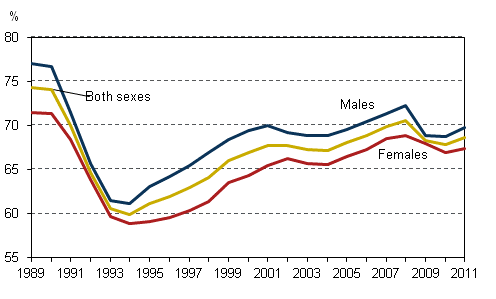
There were 2,474,000 employed persons in 2011, which was 26,000 more than in 2010. However, the number of employed persons was still lower than in 2008 (Figure 2). Employment improved in all quarters of 2011 when compared to 2010.
Figure 2. Number of employed persons by sex in 1989–2011, persons aged 15 to 74
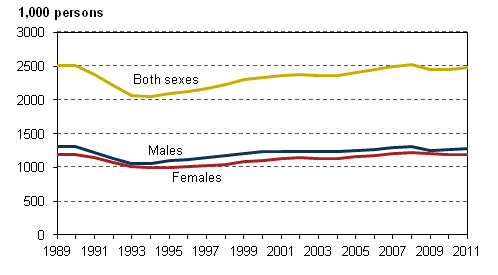
There were 2,143,000 employees in 2011, which was 23,000 more than in the previous year. The number of self-employed persons fell in 2010 but grew slightly in 2011. There were 319,000 self-employed persons and 12,000 assisting family members in 2011. The average share of all self-employed persons among employed persons was 13.4 per cent.
Men’s employment situation improved further
Men’s employment rate grew further from 2010. Figure 3 shows a time series on changes in the number of employed persons by sex. The number of employed men fell sharply in 2009 but then turned towards slight growth in 2010. In 2011, men’s employment grew by 19,000 persons from 2010. The number of employed women went up by 7,000 in 2011.
Figure 3. Change from the previous year in the number of employed persons by sex in 1991–2011, persons aged 15 to 74
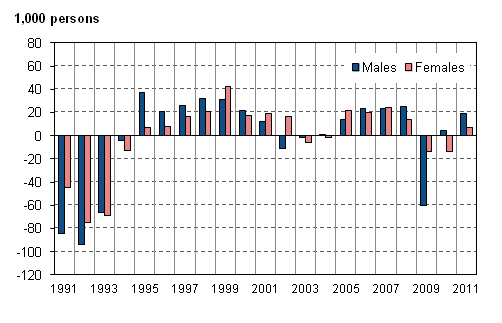
Employment grew slightly in all age groups
The rate of employment went up in most 10-year age groups in 2011 (Figure 4).
The number of the employed grew most (by 9,000) in the 15 to 24 age group. In the oldest age group of 65 to 74, the number of employed persons was 8,000 higher than in the year before. The size of population in this age group has also grown.
Figure 4. Employment rates by age group in 1989–2011, %
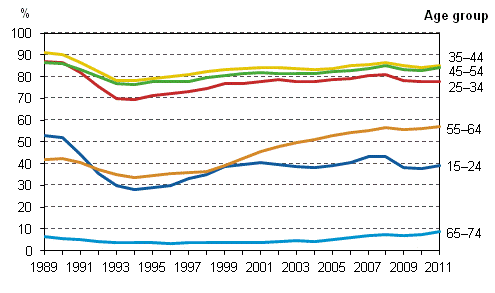
Employment improved especially in human health and social work activities
Figure 5 shows change from the previous year in the number of employed persons by industry in 2010 and 2011. In human health and social work activities (Q), the number of employed persons grew by 17,000 in 2011, whereas in the previous year it fell by 10,000. In manufacturing (C–E), the decline in the number of employed persons slowed down from 2010. In the activity of transportation and storage (H), the number of employed persons grew slightly in 2010 but fell by 9,000 in 2011.
Figure 5. Change from the previous year in the number of employed persons by industry in 2010–2011, persons aged 15 to 74
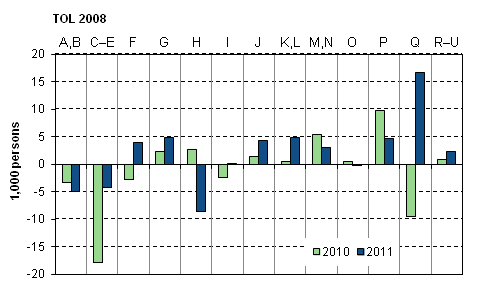
Industries (Standard Industrial Classification TOL 2008)
| A, B | 01–09 | Agriculture, forestry and fishing; mining and quarrying |
| C-E | 10–39 | Manufacturing; electricity, gas, steam and air conditioning and watersupply; sewerage and waste management |
| F | 41–43 | Construction |
| G | 45–47 | Wholesale and retail trade; repair of motor vehicles and motorcycles |
| H | 49–53 | Transportation and storage |
| I | 55–56 | Accommodation and food service activities |
| J | 58–63 | Information and communication |
| K, L | 64–68 | Financial, insurance and real estate activities |
| M, N | 69–82 | Professional, scientific and technical activities; administrativeand support service activities |
| O | 84 | Public administration and defence; compulsory social security |
| P | 85 | Education |
| Q | 86–88 | Human health and social work activities |
| R–U | 90–99 | Arts, entertainment and recreation; other service activities |
Employment increased mainly in the private sector, which employed 22,000 persons more than in 2010. In the public sector, the number of the employed grew slightly in the local government sector.
Number of hours actually worked remained almost unchanged
A total of 4.0 billion hours were worked in the national economy in 2011. The number of hours actually worked was 0.9 per cent higher in 2011 than in 2010. The number of hours actually worked per employed person remained almost unchanged from the previous year. In 2010, the average annual number of hours actually worked by an employed person was 1,634, whereas in 2011 the respective figure was 1,631.
There were fewer underemployed persons in 2011 than in the year before. While in 2010 underemployed persons numbered 120,000, in 2011 their number fell to 113,000. Underemployed persons refer to persons working involuntarily e.g. part-time or a shortened working week.
2.2 Unemployment decreased in 2011
There were 16,000 fewer unemployed persons in 2011 than in the year before. The average number of unemployed persons was 209,000. There were 117,000 unemployed men and 91,000 unemployed women. Compared to 2010, there were 9,000 fewer unemployed men and 7,000 fewer unemployed women. The number of unemployed persons decreased in each quarter of the year from the respective quarter of the previous year.
The average rate of unemployment was 7.8 per cent in 2011, having been 8.4 per cent in 2010. Men’s unemployment rate was 8.4 per cent and women’s 7.1 per cent.
Persons in disguised unemployment are economically inactive persons who would like to be gainfully employed but do not actively look for work for diverse reasons. In 2011, there were 103,000 persons in disguised unemployment, which is almost the same number as in 2010. The numbers of persons in disguised unemployment were the highest in the 15 to 24 age group (33,000) and the 55 to 64 age group (26,000). The combined total number of unemployed persons and persons in disguised unemployment was 312,000 in 2011 (Figure 6).
Figure 6. Unemployed persons and persons in disguised unemployment in 1997–2011, persons aged 15 to 74
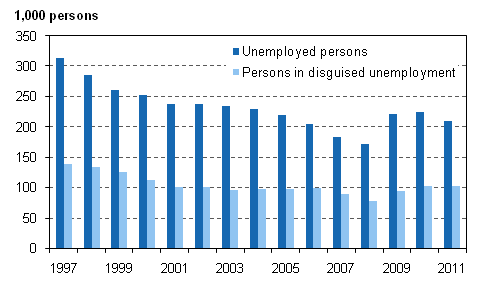
In 2011, the rate of unemployment among the population aged 15 to 24 was 20.1 per cent. The rate of unemployment among young people was 1.3 percentage points lower than in the previous year. In other age groups, rates of unemployment fell only fractionally (Figure 7). Around one-third of all unemployed persons were aged under 25. There were 65,000 unemployed persons aged 15 to 24.
The shares of the unemployed of the total age group were in 2011 almost on level with 2010. Approximately 10 per cent of the 15 to 24 age group were unemployed in 2011 (Figure 8).
Figure 7. Unemployment rates by age group in 1989–2011, %
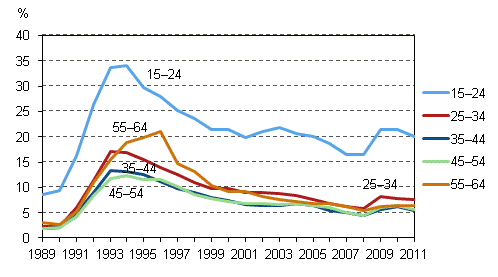
Figure 8. Shares of employed and unemployed persons, and inactive population of age group in 2011, %
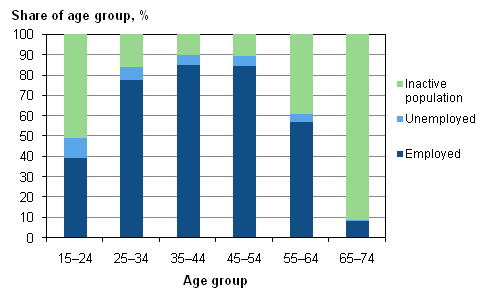
The average number of temporarily laid-off persons was 12,000 in 2011 whereas in the previous year it was 21,000. The number of laid-off persons decreased in every quarter compared to the quarters of 2010 (Table 1).
Table 1. Temporarily laid-off persons aged 15–74 by quarter in 2009–2011
| Year | |||
| 2009 | 2010 | 2011 | |
| Quarter | Persons | Persons | Persons |
| I | 38,000 | 35,000 | 18,000 |
| II | 42,000 | 19,000 | 11,000 |
| III | 31,000 | 15,000 | 9,000 |
| IV | 36,000 | 14,000 | 11,000 |
| Annual mean | 37,000 | 21,000 | 12,000 |
In 2011, 22 per cent of the temporarily laid-off persons were defined as unemployed, 33 per cent as employed and 44 per cent as belonging to the inactive population.
2.3 Size of active population grew in 2011
From 2010 to 2011, the size of the population of working age grew by 15,000 persons in Finland. In 2011, the size of Finland’s population of working age, i.e. aged 15 to 74, was 4,059,000 persons. The size of the population aged between 65 and 74 grew by most (31,000). Persons aged 55 to 64 form the largest age group in the population of working age (Figure 9).
The size of the active population grew by 11,000 persons in 2011. Activity rate went up between 2010 and 2011 in all other age groups except for the 25 to 34-year-olds where it remained almost unchanged.
The size of the inactive population was 1,376,000 in 2011. Its size grew by 5,000 persons from the previous year. The inactive population grew only in the 65 to 74 age group. In the 15 to 64 age group, the size of the inactive population decreased.
Figure 9. Population of working age and active population by age group in 2011
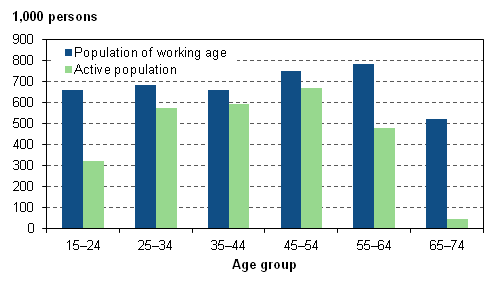
2.4 Number of employees whose present work has continued less than one year grew in 2011
Temporary employment contracts more usual among women than men
In 2011, the average number of employees in Finland was 2,143,000, which was 23,000 higher than in 2010. The number of employees with permanent employment contracts grew by 17,000 and that of employees with temporary contracts by 6,000. Altogether 336,000 employees held temporary employment contracts (Figure 10). Temporary employment continues to be more widespread among women than men. In 2011, 202,000 of all temporary employees were women and 135,000 men.
Figure 10. Number of temporary employees aged 15 to 74 by sex in 1999–2011
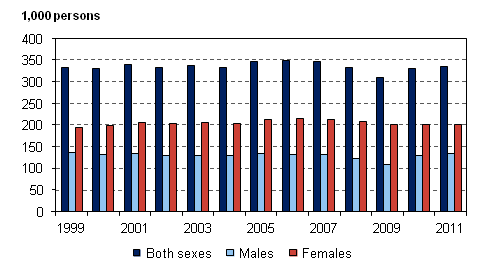
Eighty-four per cent of all employees’ employment contracts were permanent and 16 per cent temporary in 2011. The shares were unchanged from the previous year. The share of temporary employees among all employees was still below the long-term average. Among female employees, the share of temporary employees was 19 per cent and among male employees 13 per cent. The number and share of temporary employment contracts grew slightly among male employees in 2011. Among female employees, they remained on level with the year before (Figure 11).
Figure 11. Share of temporary employees of all employees aged 15 to 74 by sex in 1997–2011, %
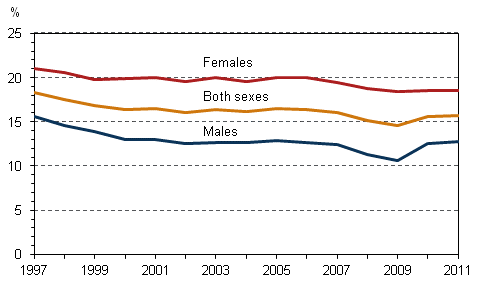
Compared to the respective period of the previous year, the number of temporary employment contracts went up most in the first quarter of 2011. By contrast, the number of temporary employment contracts decreased slightly during the last quarter of the year.
Two out of three temporary employees would want a permanent job
To an employee, temporary employment can be either a desired or involuntary form of employment. Approximately 27 per cent of temporary employees did not want a permanent job in 2011. The majority of them were aged between 15 and 24. Summer workers are a typical group of persons working voluntarily in temporary jobs.
However, a more common reason for working in a temporary employment relationship is that permanent work cannot be found. In 2011, the lack of permanent work was the reason why around 63 per cent of temporary employees worked in temporary jobs. The share of persons working involuntarily in temporary jobs among all temporary employees remained almost unchanged from 2010 to 2011.
In 2011, there were 208,000 temporary employees on the labour market who had not found a permanent job even though they would have wanted one. Of them, 129,000 were women and 79,000 men. Involuntary working under temporary contracts increases with age.
Number of employees whose present work has continued less than one year grew in 2011
The number of employees whose present work has continued less than one year grew clearly from 2010 to 2011. There were 446,000 such new employment contracts in 2011, or some 53,000 more than in 2010 (Figure 12).
Figure 12. Employees whose present work has continued less than one year aged 15 to 74 in 1999–2011
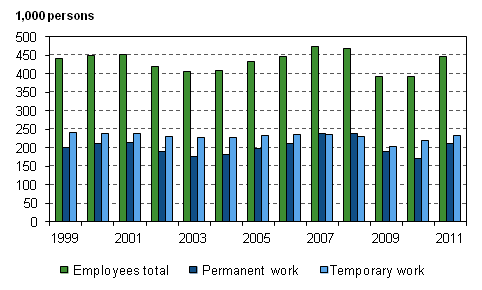
Fifty-two per cent of such new employment contracts were temporary. The share was one percentage point smaller than in 2010 and four percentage points smaller than in 2009.
There has been a clear difference between women and men in whether a new employment contract is temporary or permanent. The situation has remained very similar since 1997 when a comparable time series begins. In 2011, 58 per cent of women’s and 46 per cent of men’s new employment contracts were temporary.
Only one per cent of employees did temporary agency work
Temporary agency work refers to an employment relationship in which an employee works via an enterprise that intermediates or hires labour force. Data on temporary agency work have been collected in the Labour Force Survey since 2008. In 2011, the average number of persons doing temporary agency work was 28,000, or about the same as in 2010. Approximately one-half of the temporary agency workers were women.
Temporary agency workers only made up one per cent or so of all employees in 2011. Thus, doing temporary agency work is quite a marginal form of working on the Finnish labour market. Temporary agency work is mainly done by young people; around five per cent of 15 to 24-year-old employees were doing it.
Temporary agency workers are employed by several industries. Their use is commonest in wholesale and retail trade, hotel and restaurant activities, and in manufacturing. Each of these industries employed a couple of thousand temporary agency workers.
2.5 Number of part-time employees went up slightly
Number of part-time employees highest in female-dominated industries
According to the Labour Force Survey, 369,000 employed persons worked part-time in 2011. Some 15 per cent of all employed persons worked part time. Of them, 307,000 were employees. The Labour Force Survey data on part-time employment is based on the respondents’ own reporting. The following only concerns part-time employees.
The number of part-time employees grew slightly (+12,000) from the previous year in 2011 Part-time employees made up 14 per cent of all employees in 2011. The long-term trend in part-time employment has been a growing one since 1997. Part-time employment is more widespread among women than men. Persons employed part-time numbered 211,000, or 19 per cent, among female employees and 96,000, or 9 per cent, among male employees. (Figures 13 and 14.)
Nearly three-quarters of the part-time employees worked in the private sector. The numbers of part-time employees were the highest in the female-dominated industries of wholesale and retail trade, and human health and social work activities. The share of part-time employees of all employees was the largest, or 38 per cent, in retail trade (excl. motor vehicle trade).
Figure 13. Part-time employees aged 15 to 74 by sex in 1999–2011
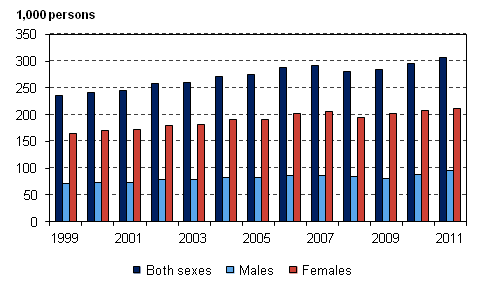
Figure 14. Share of part-time employees among employees aged 15 to 74 by sex 1997–2011, %
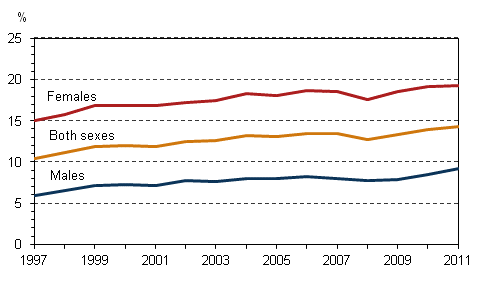
Studying is still the commonest reason for working part-time
Working part-time suits the life situation of many of those who are employed part-time. By contrast, part-time employment can be viewed as one form of underemployment in cases where the employee has not succeeded in finding full-time work even if he/she would have wanted it.
In 2011, studying was again the commonest reason why employees worked part-time. Approximately 28 per cent of part-time employees quoted this reason. Working part-time is most widespread among employees between the ages of 15 and 24 of whom 39 per cent worked part-time in 2011.
Other reported reasons related to life situation were caring for children or relatives, and health reasons. Nearly all of those who reported caring for children or relatives as the reason for working part-time were women. For good one-quarter of part-time employees, the reason for working part-time was that full-time work was not available. In 2011, employees working part-time involuntarily numbered 82,000, of whom 58,000 were women and 24,000 men.
Among the 55 to 64-year-old employees, the number of part-time workers was 65,000, which was nearly 18 per cent of all employees in this age group.
Source: Labour force survey 2011. Statistics Finland
Inquiries: Veli Rajaniemi 09 1734 3434, Heidi Melasniemi-Uutela 09 1734 2523, Tarja Nieminen 09 1734 3561, tyovoimatutkimus@stat.fi
Director in charge: Riitta Harala
Updated 6.11.2012
Official Statistics of Finland (OSF):
Labour force survey [e-publication].
ISSN=1798-7857. Time series data 2002-2011 2011,
2 Employment and unemployment in 2011
. Helsinki: Statistics Finland [referred: 3.1.2026].
Access method: http://stat.fi/til/tyti/2011/15/tyti_2011_15_2012-11-06_kat_002_en.html

